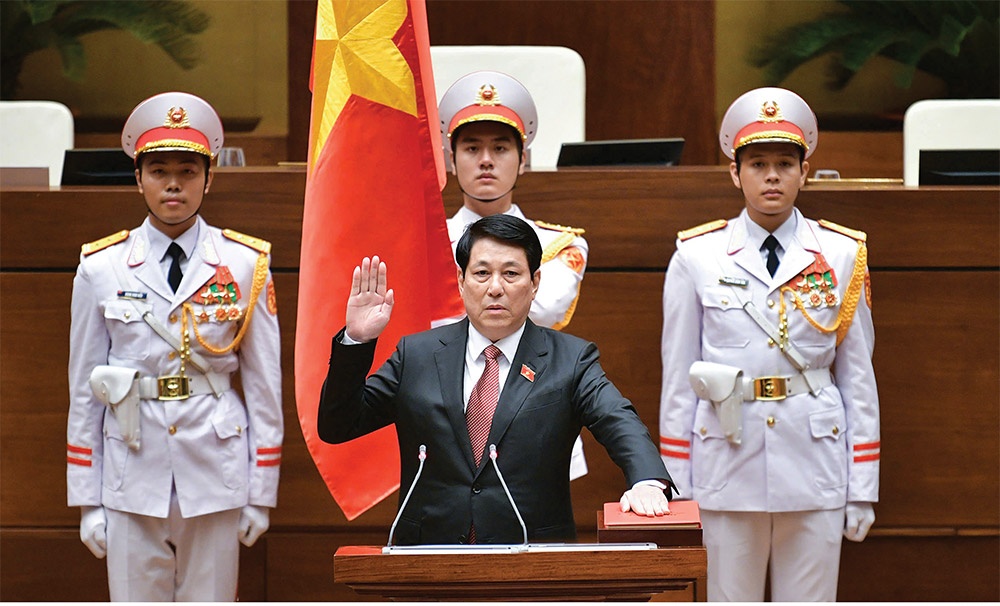Leadership focused on economic progress
The 15th-tenure National Assembly (NA) last week adopted a resolution on the election of Luong Cuong, Politburo member, permanent member of the 13th-tenure Party Central Committee’s Secretariat, and NA deputy of the 15th tenure, as State President of Vietnam for the 2021-2026 term. The resolution received support from all 440 deputies present at the meeting, tantamount to nearly 92 per cent of the total number of NA deputies.
 |
| Newly-elected State President Luong Cuong taking the oath of office |
After the ballot, President Cuong, 67, born in the northern province of Phu Tho, took the oath of office under the flag and before the NA and constituents nationwide, vowing to “be completely faithful to the country, people, and the Constitution of the Socialist Republic of Vietnam,” and he will do his utmost “to accomplish all tasks assigned by the Party, the state, and the people”.
He committed to pursuing a consistent foreign policy of independence, self-reliance, peace, friendship, cooperation and development, diversification and multilateralism of external ties, active and proactive global integration, and ensuring the highest national interests.
“Vietnam will continue to be a trusted friend and partner, an active and responsible member of the global community, resolutely safeguard its independence, sovereignty, and territorial integrity, while maintaining an environment of peace and stability for national construction and development,” he said.
Along with President Cuong, Vietnam’s other current leaders are Party General Secretary To Lam, Prime Minister Pham Minh Chinh, and NA Chairman Tran Thanh Man.
The government last week reported to the legislative body that in 2024 and 2025, the government will continue prioritising growth linked with maintaining macroeconomic stability, controlling inflation, and ensuring major balances of the economy.
It also strives to improve institutions and laws; develop infrastructure; improve the quality of human resources; develop science and technology, and innovation; and boost digital transformation, green transition, and the circular economy.
The traditional growth impetuses include investment, consumption, and exports, while the new growth propellants consist of regional connectivity, digital transformation, the green transition, and new industries such as semiconductors and AI, among others.
Efforts are also to be made to effectively implement Vietnam’s semiconductor industry development strategy. The strategy, issued in September, outlines a specific roadmap for developing the industry, and under which Vietnam will strive to become a new and safe destination of the global semiconductor supply chain.
The industry is set to be developed in three periods. In the first period, from now to 2030, it will use geopolitical and workforce advantages, selectively attract foreign direct investment, establish itself as one of the global semiconductor manpower centres, and grow fundamental capacity in all steps, from research, design, and manufacturing to packaging and testing.
In the second phase from 2030 to 2040, Vietnam will work to become a global semiconductor and electronics centre while developing the semiconductor and electronics industries that combine both self-reliance and foreign investment. During this phase, Vietnam targets respective annual revenues of over $50 billion and $485 billion for the semiconductor and electronics industries, which are expected to record an added value growth rate of 15-20 per cent.
For the third phase to 2050, the nation is aiming to become of the world’s leaders in the semiconductor and electronics industries. In this period, these industries are expected to reap respective annual revenues of over $100 billion and $1 trillion, as well as a growth rate of 20-25 per cent in added value.
In August, Prime Minister Chinh established a national steering committee on semiconductor industry development, paving the way for the country’s future in the industry.
The committee’s establishment coincides with the national trajectory of deeper integration into regional and global semiconductor value chains. By 2030, Vietnam plans to profoundly engage in the semiconductor packaging and testing process, which will be executed by mastering part of the associated technology and training 50,000 engineers.
At present, the country has nearly 160 out of about 240 universities providing technology training and ready to expand to semiconductors, as well as 35 educational institutions offering majors related to semiconductors.
What the stars mean:
★ Poor ★ ★ Promising ★★★ Good ★★★★ Very good ★★★★★ Exceptional
Related Contents
Latest News
More News
- Protect what’s next: towards a future free from meningococcal group B disease (December 05, 2025 | 18:00)
- New ILO report offers policy recommendations for disability inclusion (December 04, 2025 | 15:18)
- Maternal job loss may affect children’s mental health, research shows (December 03, 2025 | 19:11)
- Women lead Vietnam’s shift to climate-resilient agriculture (December 03, 2025 | 19:10)
- Experts highlight unpaid care work as key barrier to gender equality (December 03, 2025 | 15:15)
- Opportunities and inequalities for women workers in Vietnam's garment industry (December 03, 2025 | 09:00)
- Vietjet flights carry love to devastated central region (November 28, 2025 | 11:35)
- New initiative to boost the fight against domestic violence (November 26, 2025 | 10:00)
- South Korea funds IOM relief for Vietnam’s typhoon-affected communities (November 24, 2025 | 15:33)
- AI and human-centred values set to shape the future of HR in Vietnam (November 21, 2025 | 18:04)

 Tag:
Tag:





















 Mobile Version
Mobile Version